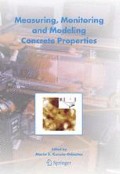Abstract
This paper discusses the adequateness of the steady state flat crack criterion for crack propagation in Engineered Cementitious Composites. The requirement of a minimum complementary energy for the fiber bridging curve is found not to be relevant in the aim of controlling the crack opening under crack propagation.
Access this chapter
Tax calculation will be finalised at checkout
Purchases are for personal use only
Preview
Unable to display preview. Download preview PDF.
References
D.B. Marshall, and B.N. Cox. A J-integral method for calculating steady-state matrix cracking stresses in composites. Mech. Mat., 8, 127–133, (1988).
A. Hillerborg, M. Modeer and P.E. Petersson. Analysis of Crack Formation and Crack Growth in Concrete by Means of Fracture Mechanics and Finite Elements. Cem. Concr. Res.,6, 773–782, (1976).
L. Dick-Nielsen, P.N. Poulsen H. Stang and J.F. Olesen. Semi-analytical cohesive crack model for the analysis of first crack strength of mortar. Proc. of the 17th Nordic Seminar on Computational Mechanics, 183–186, (2004).
L. Østergaard, J. F. Olesen, H. Stang and D. A. Lange. A simple and fast method for interpretation and inverse analysis of the wedge splitting test. Submitted for publication.
Z. Lin, T. Kanda and V.C. Li. On interface property characterization and performance of fiber-reinforced cementitious composites Concrete Science and Engineering,1, 173–184, (1999).
V.C. Li, H. Stang, and H. Krenchel, Micromechanics of Crack Bridging in Fiber Reinforced Concrete, Materials and Structures, 26, 486–494, (1993).
L. Dick-Nielsen, H. Stang and P.N. Poulsen. Micro-mechanical Analysis of Fiber Reinforced Cementitious Composites using Cohesive Crack Modeling. Proceedings of the Knud Højgaard conference, (2005).
S. Wang, Private communication. DTU, 2004
H. Stang, J. F. Olesen, P. N. Poulsen and L. Dick-Nielsen. On the Application of Cohesive Crack Modeling in Cementitious Materials. Proceedings of the Knud Højgaard conference, (2005).
SCE. Tentative Guideline for Design and Constructions of Engineering Cementitious Composites-ECC. (Draft) JSCE TC, 334, (2005).
Author information
Authors and Affiliations
Editor information
Editors and Affiliations
Rights and permissions
Copyright information
© 2006 Springer
About this paper
Cite this paper
Dick- Nielsen, L., Stang, H., Poulsen, P. (2006). CONDITION FOR STRAIN-HARDENING IN ECC UNIAXIAL TEST SPECIMEN. In: KONSTA-GDOUTOS, M.S. (eds) Measuring, Monitoring and Modeling Concrete Properties. Springer, Dordrecht. https://doi.org/10.1007/978-1-4020-5104-3_5
Download citation
DOI: https://doi.org/10.1007/978-1-4020-5104-3_5
Publisher Name: Springer, Dordrecht
Print ISBN: 978-1-4020-5103-6
Online ISBN: 978-1-4020-5104-3
eBook Packages: EngineeringEngineering (R0)

